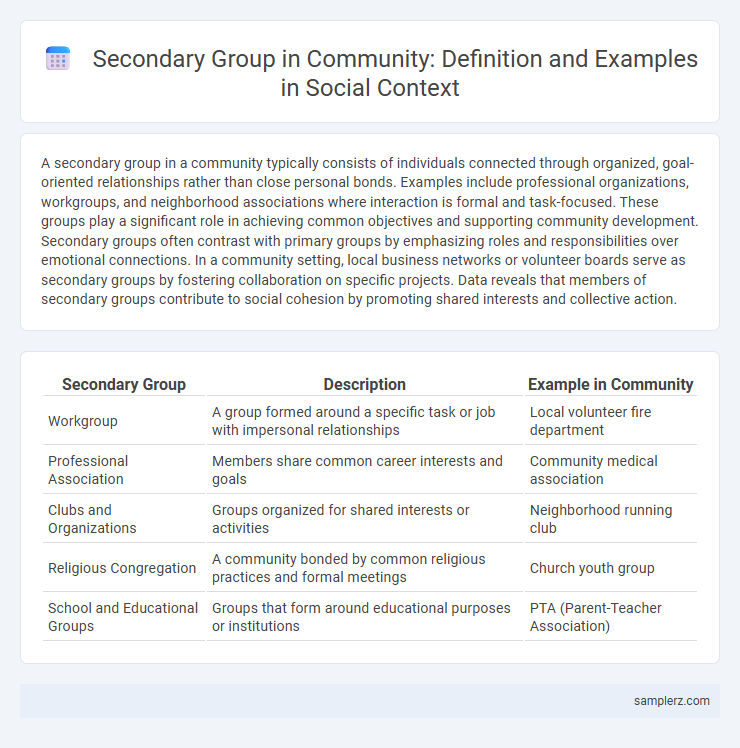A secondary group in a community typically consists of individuals connected through organized, goal-oriented relationships rather than close personal bonds. Examples include professional organizations, workgroups, and neighborhood associations where interaction is formal and task-focused. These groups play a significant role in achieving common objectives and supporting community development. Secondary groups often contrast with primary groups by emphasizing roles and responsibilities over emotional connections. In a community setting, local business networks or volunteer boards serve as secondary groups by fostering collaboration on specific projects. Data reveals that members of secondary groups contribute to social cohesion by promoting shared interests and collective action.
Table of Comparison
| Secondary Group | Description | Example in Community |
|---|---|---|
| Workgroup | A group formed around a specific task or job with impersonal relationships | Local volunteer fire department |
| Professional Association | Members share common career interests and goals | Community medical association |
| Clubs and Organizations | Groups organized for shared interests or activities | Neighborhood running club |
| Religious Congregation | A community bonded by common religious practices and formal meetings | Church youth group |
| School and Educational Groups | Groups that form around educational purposes or institutions | PTA (Parent-Teacher Association) |
School Clubs as Secondary Groups in Communities
School clubs serve as quintessential secondary groups within communities, fostering structured interactions among members who share common interests or goals beyond primary family ties. These clubs facilitate social integration, skill development, and collective identity formation, contributing to the broader social fabric of educational environments. Membership in such groups enhances networking opportunities and promotes civic engagement among youth, reinforcing social cohesion within the community.
Workplace Teams: Building Connections Beyond the Family
Workplace teams represent a prime example of secondary groups in a community, where individuals collaborate based on shared professional goals rather than personal relationships. These teams foster connections that enhance productivity, communication, and problem-solving skills within an organizational setting. Through structured roles and common objectives, workplace teams contribute significantly to social cohesion beyond familial ties.
Religious Organizations: Fostering Social Bonds
Religious organizations serve as key examples of secondary groups within communities, uniting individuals through shared beliefs and collective rituals. These groups facilitate social bonds by creating structured settings for interaction, collaboration, and mutual support beyond primary, personal relationships. Their organized activities and communal events promote cohesion, identity, and a sense of belonging, reinforcing the social fabric of the community.
Volunteer Groups: Uniting for a Common Cause
Volunteer groups exemplify secondary groups in communities by bringing together individuals with a shared goal of addressing social issues or supporting local initiatives. These groups foster cooperation and collective action without the deep personal connections typical of primary groups, emphasizing roles, tasks, and organizational structure. Their impact is seen through coordinated efforts in charity drives, environmental clean-ups, and community support programs.
Professional Associations: Networking Outside Primary Circles
Professional associations serve as prime examples of secondary groups within communities, offering members opportunities to network beyond their primary social circles. These organizations facilitate connections through conferences, workshops, and online forums, promoting knowledge exchange and career advancement. Membership in such groups enhances social capital by linking individuals across diverse industries and geographic regions.
Sports Teams: Creating Community Through Shared Interests
Sports teams serve as a prime example of secondary groups in a community, where individuals unite beyond personal relationships through a mutual passion for athletics. These teams foster a sense of belonging and collective identity by participating in organized games, practices, and events that emphasize common goals. Through collaboration and competition, sports teams strengthen social bonds and support networks within the broader community framework.
Neighborhood Associations: Enhancing Community Engagement
Neighborhood associations serve as vital secondary groups that foster social interaction and cooperation among residents within a community. These organizations coordinate events, address local issues, and promote collective decision-making, thereby strengthening neighborhood ties and enhancing civic participation. By facilitating communication and collaboration, neighborhood associations contribute significantly to building a cohesive and active community environment.
Online Social Communities: Digital Era Secondary Groups
Online social communities exemplify secondary groups in the digital era, characterized by large networks of individuals connected through shared interests rather than personal relationships. These groups facilitate interactions based on common goals, such as gaming forums, professional networks like LinkedIn, and hobbyist platforms like Reddit. The transient and goal-oriented nature of these digital secondary groups contrasts with the intimate bonds found in primary groups, emphasizing collaboration and information exchange.
Political Interest Groups: Mobilizing Community Actions
Political interest groups serve as prime examples of secondary groups within communities by uniting individuals around shared political goals and values. These organizations mobilize community actions through advocacy campaigns, lobbying efforts, and public demonstrations, significantly influencing local and national policy decisions. By fostering collective participation, political interest groups enhance civic engagement and amplify the community's voice in the political arena.
Support Groups: Connecting Individuals Through Shared Experiences
Support groups serve as a vital secondary group within communities by connecting individuals who share similar challenges such as chronic illness, addiction recovery, or grief. These groups provide structured emotional support, resources, and a sense of belonging, fostering resilience and personal growth. Through regular meetings and peer interactions, members develop empathetic networks that complement primary social relationships and enhance overall community well-being.

example of secondary group in community Infographic
 samplerz.com
samplerz.com